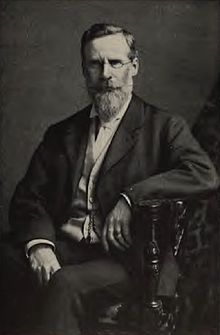威廉·克魯克斯
威廉·克魯克斯爵士,OM,FRS(英語:Sir William Crookes,1832年6月17日—1919年4月4日),英國物理學家、化學家,參與皇家化學學院,致力於光譜學研究。
| 威廉·克魯克斯 爵士 Sir William Crookes | |
|---|---|
 | |
| 出生 | 1832年6月17日 |
| 逝世 | 1919年4月4日(86歲) |
| 國籍 | 英國 |
| 知名於 | 發現鉈元素、發明輻射計、克魯克斯管 |
| 獎項 | 皇家獎章(1875年) 戴維獎章(1888年) 阿爾伯特獎章(1899年) 科普利獎章(1904年) 艾略特·克雷松獎章(1912年) |
| 科學生涯 | |
| 研究領域 | 物理化學 |
威廉·克魯克斯於1859年創辦並主編《化學新聞》。1863年當選英國皇家學會院士,1913年至1915年間擔任皇家學會會長。是鉈元素的發現和命名者,以及真空管研究先驅。其1874年研製的陰極射線管(克魯克斯管),為1895年X射線的發現和1897年電子的發現提供了基本實驗條件。他同時也發明閃爍鏡等實驗儀器和防護游離輻射的特種玻璃,研究稀土元素及其光譜、空氣中固氮等問題,並以此在1873年發明了輻射計(克魯克斯輻射計)[1]。
生平
編輯早年
編輯威廉·克魯克斯出生於倫敦,有15個弟妹。他的父親約瑟夫·克羅克斯(Joseph Crookes)是北方出身的裁縫,當時和他第二任妻子瑪麗·史考特(Mary Scott Lewis Rutherford Johnson)住在一起。
1850年至1854年,他擔任了大學的助理職位,很快開始原創性的工作。他沒有走向他的老師馮·霍夫曼的有機化學領域,而是研究新的硒化合物,這成為他1851年首次發表論文的主題。之後1854年他在牛津的雷德克里夫天文台與曼紐·約翰·約翰遜一起工作,在那裡他將最新的蠟紙攝影技術與法蘭西斯·羅納茲製造的機器相結合,可以連續記錄氣象數據[2]。 1855年,他被任命為赤斯特大學的化學講師。
1856年,他與達倫頓威廉·漢弗萊(William Humphrey of Darlington)的女兒艾倫(Ellen)結婚,有三個兒子和一個女兒,生活在倫敦。1859年,創辦了《化學新聞》。這本雜誌是他編輯多年的科學雜誌,不過規模小於當時一般主流科學期刊。
中年
編輯克魯克斯在實驗上有眾多成果。他以極大的熱情接受本生和古斯塔夫·基爾荷甫介紹的光譜分析方法。1861年,他發現一個過去未知的元素,光譜中有一明亮的綠色發射譜線,因此取希臘語「θαλλός」(thallos)—「綠芽」之意,命名為元素鉈(thallium)。 這項工作使他的名聲確立,1863年當選為英國皇家學會院士。1871年他也在《化學分析選擇方法》上發表論文。
克魯克斯是建造和使用真空管來研究物理現象的先驅[3]。1874年他開發了克魯克斯管[4],研究陰極射線,發表了許多關於光譜學的論文,並對其中各個子領域進行研究。他在低壓氣體導電研究中發現,隨著壓力的降低,負極(陰極)似乎會發出光線(即所謂的「陰極射線」,現在已知是一股自由電子流,並可用於映像管)。因此,他也可以說是第一批研究後來所謂電漿的科學家之一,並在1879年認為這是第四種物質狀態[5]。他還設計了閃爍鏡,是最初幾種研究核放射性的方法之一。
克魯克斯研究陰極射線的性質,表明它們以直線行進,當它們落在某些物質上時會引起熒光,並且可以產生很大的熱量。他因此相信他發現了第四種物質狀態,他稱之為「輻射質」(Radiant Matter)[6]。他認為光線由一般分子量級的粒子流組成。後來約瑟夫·湯姆森也類似這樣解釋陰極射線的亞原子性質(由負電子流組成)。雖然之後不久克魯克斯的「輻射質」理論觀點被取代[7],他在此領域的實驗工作是許多發現的基礎,並最終改變了整個化學和物理學。
在研究鉈元素的過程中,他注意到真空平衡。 他很快就發現了一種驅動克魯克斯輻射計的現象,當暴露於輻射能量時,克魯克斯輻射計的葉片暗面會離開輻射源,亮面會靠近輻射源而轉動。然而,克魯克斯沒有提出這種明顯「輻射引起的吸力和斥力」的真正解釋。
1880年後,他住在肯辛頓公園花園(Kensington Park Gardens)的私人實驗室裡,完成他所有的後期工作。
晚年
編輯克魯克斯在1895年確定了第一個已知的氦樣品。1897年被封為爵士。1903年,克魯克斯把注意力轉移到新發現的放射性現像,實現了鈾元素與其放射性衰變產物「鈾-X」(後來被確定為鏷元素)的分離。 他觀察到分離衰變產物的逐漸衰減,以及原始鈾中同時有新鮮的供應。 在這個重要發現的同時,他也觀察到當放射性活性物質中放射出的「p粒子」撞擊到硫化鋅時,每次沖擊都伴隨著微小的閃爍,這種現象成為了日後放射性技術中最有用的方法之一。
心靈論
編輯1860年代後期,可能因為克魯克斯的一個弟弟在21歲時死於黃熱病[8][9],克魯克斯開始對心靈論論感興趣。1867年,受到瓦利(Crickwell Fleetwood Varley)的影響,克魯克斯出席了一次降神會,試圖與他的兄弟聯繫 [10][11]。在1871年至1874年間,克魯克斯與當時的靈媒凱特·福克斯,佛羅倫斯·庫克和丹尼爾·東拉斯·亨姆合作了一些研究。經過調查,他認為這些靈媒可能產生真正的超常現象,並與精神交流[12][13]。但後來的心理學家Leonard Zusne和Warren H. Jones則認為克魯克斯非常可笑,把詐欺的靈媒當成是真實的[14]。科學史學家Sherrie Lynne Lyons也認為克魯克斯是被欺騙的[15]。
克魯克斯後來加入了心靈現象研究學會,成為1890年代的會長,他也加入了神智學協會和靈魂俱樂部[8]。1890年,他開始進入黃金黎明協會[16]。
參考資料
編輯- ^ 美國專利第182,172號, Improvement In Apparatus For Indicating The Intensity Of Radiation
- ^ Ronalds, B.F. Sir Francis Ronalds: Father of the Electric Telegraph. London: Imperial College Press. 2016. ISBN 978-1-78326-917-4.
- ^ Alexander E. Outerbridge, Jr., A Fourth State of Matter. Lecture delivered before the Franklin Institute, 17 February 1881. Journal of the Franklin Institute of the State of Pennsylvania, Volume 81. By Franklin Institute (Philadelphia, Pa.). Page 287+ (頁面存檔備份,存於網際網路檔案館).
- ^ The difference between "Crookes tubes" and "Geissler tubes" is this: In a Geissler tube the exhaustion is very much less than in a Crookes tube, the light which we see in the Geissler tube being due to the luminescence of the residual gas. (Transactions, Volume 9. Hertfordshire Natural History Society and Field Club. The Club, 1898. Page 136 (頁面存檔備份,存於網際網路檔案館).)
- ^ William Crookes, On Radiant Matter. Lecture delivered before the British Association for the Advancement of Science, at Sheffield, Friday, 22 August 1879. The Popular Science Monthly, Volume 16. D. Appleton, 1880. Pg157+ (頁面存檔備份,存於網際網路檔案館)
- ^ Radio-activity induced by the oscillatory discharge, or, The subsequent radio-active emanation from substances exposed to the Tesla oscillatory discharge. Harry Marshall Diemer, Ralph Stuart Cooper. Cornell University, 1903. Page 43+ (頁面存檔備份,存於網際網路檔案館).
- ^ Chemist & Druggist, Volume 60. Benn Brothers., 1902. Pg 268 (頁面存檔備份,存於網際網路檔案館).
- ^ 8.0 8.1 Janet Oppenheim. (1988). The Other World: Spiritualism and Psychical Research in England, 1850-1914. Cambridge University Press. pp. 343–347. ISBN 978-0521265058
- ^ John Hannavy. (2007). Encyclopedia of Nineteenth-Century Photography. Routledge. p. 350. ISBN 978-0415972352 "Crookes' beloved younger brother had died in 1867 and the scientist hoped that spiritualism could provide a reunion. Although warned of the risk of ridicule, Crookes announced his intent to investigate mediums."
- ^ Sherrie Lynne Lyons. (2010). Species, Serpents, Spirits, and Skulls: Science at the Margins in the Victorian Age. State University of New York Press. p. 92. ISBN 978-1438427980 "Crookes appears to have been initially attracted to spiritualism when his youngest brother, whom he was quite close to, died of yellow fever. Brought up with the traditional Christian belief in the afterlife, Crookes was persuaded to attend a séance in 1867 to try to make contact with his brother."
- ^ Martyn Jolly. (2006). Faces of the Living dead: The Belief in Spirit Photography. Miegunyah Press. p. 30. ISBN 978-0712348997 "In 1867, he was devastated by the death of his much-loved youngest brother who, at the age of twenty-one. had caught yellow fever while laying a submarine telegraph cable in Cuba. At the time, Crookes was collaborating with a fellow electro-physicist Cromwell Fleetwood Varley, who was a pioneer of intercontinental telegraphy, as well as a clairvoyant. He persuaded Crookes to try to get in touch with his dead brother by spiritualist means."
- ^ Daniel Cohen. (1971). Masters of the Occult. Dodd, Mead & Company. p. 111. ISBN 978-0396064077
- ^ Andrew Neher. (2011). Paranormal and Transcendental Experience: A Psychological Examination. Dover Publications. p. 214. ISBN 978-0486261676 "William Crookes, the noted English physicist, had endorsed Catherine Fox as genuine... Crookes also endorsed several other mediums who were later exposed, including Anna Eva Fay (who was exposed more than once and who eventually explained how she duped Crookes), Florence Cook (who was the subject of more than one expose), and D. D. Home."
- ^ Leonard Zusne; Warren H. Jones. (2014). Anomalistic Psychology: A Study of Magical Thinking. Psychology Press. p. 216. ISBN 978-0-805-80508-6 "The fact is that William Crookes, although very good at physics experiments, was rather weak on drawing inferences and on theorizing. Besides, he was gullible. He endorsed several mediums in spite of their demonstrated trickery. Having witnessed a single seance with Kate Fox, he became convinced that the Fox sisters' rappings were genuine."
- ^ Sherrie Lynne Lyons. (2010). Species, Serpents, Spirits, and Skulls: Science at the Margins in the Victorian Age. State University of New York Press. p. 101. ISBN 978-1438427980
- ^ Alex Owen. The Place of Enchantment: British Occultism and the Culture of the Modern. Chicago: University of Chicago Press. 2007: 70.